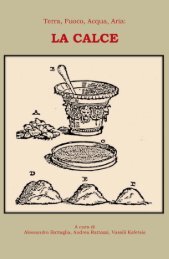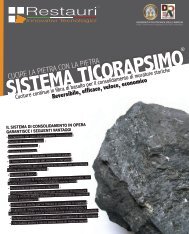Il recupero e la conservazione di volte in camorcanna di pregio ...
Il recupero e la conservazione di volte in camorcanna di pregio ...
Il recupero e la conservazione di volte in camorcanna di pregio ...
Create successful ePaper yourself
Turn your PDF publications into a flip-book with our unique Google optimized e-Paper software.
Appen<strong>di</strong>ce B<br />
- <strong>Il</strong> prodotto, opportunamente trattato, può essere rif<strong>in</strong>ito con rasanti, <strong>in</strong>tonaci,<br />
vernici o con protezioni ant<strong>in</strong>cen<strong>di</strong>o (<strong>in</strong> questo caso contattare il nostro Ufficio<br />
Tecnico).<br />
Applicazione<br />
Per <strong>la</strong> realizzazione dei vari tipi d’<strong>in</strong>tervento consultare i capito<strong>la</strong>ti <strong>di</strong> riferimento e le<br />
schede tecniche dei materiali da utilizzare. Nel caso <strong>di</strong> strutture <strong>in</strong> cemento armato,<br />
realizzare i p<strong>la</strong>ccaggi su superfici che abbiano una resistenza a trazione superiore a 1,5<br />
MPa. Una volta preparata <strong>la</strong> superficie oggetto dell’<strong>in</strong>tervento, spalmare l’adesivo<br />
epossi<strong>di</strong>co Kimitech EP‐TX, previa applicazione <strong>di</strong> un idoneo primer (consultare il nostro<br />
Ufficio Tecnico). A fresco, stendere il tessuto e, con apposito rullo metallico, esercitare<br />
una leggera pressione su <strong>di</strong> esso per permettere all’adesivo <strong>di</strong> fuoriuscire leggermente<br />
dalle maglie del tessuto stesso; questa operazione servirà per l’adesione uniforme del<br />
tessuto ed eviterà pericolose formazioni <strong>di</strong> bolle d’aria. A fresco applicare sul tessuto, a<br />
pennello, l’impregnante epossi<strong>di</strong>co Kimitech EP‐IN.<br />
Per l’applicazione <strong>di</strong> più strati sovrapposti <strong>di</strong> Kimitech ST300, consultare il nostro Ufficio<br />
Tecnico.<br />
Caratteristiche Valore tipico<br />
Peso totale del nastro 300 g/m 2<br />
Densità 1,8 g/m 3<br />
Orientamento fibre (bi<strong>di</strong>rezionale)<br />
Spessore tessuto<br />
Or<strong>di</strong>to (carbonio) 50%<br />
Trama 50%<br />
Or<strong>di</strong>to 0,083 mm<br />
Trama 0,083 mm<br />
Larghezza nastro 100 cm<br />
Colore Nero<br />
Tensione <strong>di</strong> rottura a trazione del fi<strong>la</strong>to 4800 MPa<br />
Resistenza unitaria 398 N/mm<br />
Modulo e<strong>la</strong>stico a trazione 230 GPa<br />
Allungamento a trazione 1,9%<br />
<strong>Il</strong> <strong>recupero</strong> e <strong>la</strong> <strong>conservazione</strong> <strong>di</strong> <strong>volte</strong> <strong>in</strong> <strong>camorcanna</strong> <strong>di</strong> <strong>pregio</strong> me<strong>di</strong>ante l’utilizzo <strong>di</strong> frp:<br />
analisi sperimentali e applicazione al p<strong>la</strong>fone del Teatro dei Fi<strong>la</strong>rmonici <strong>di</strong> Ascoli Piceno<br />
175





